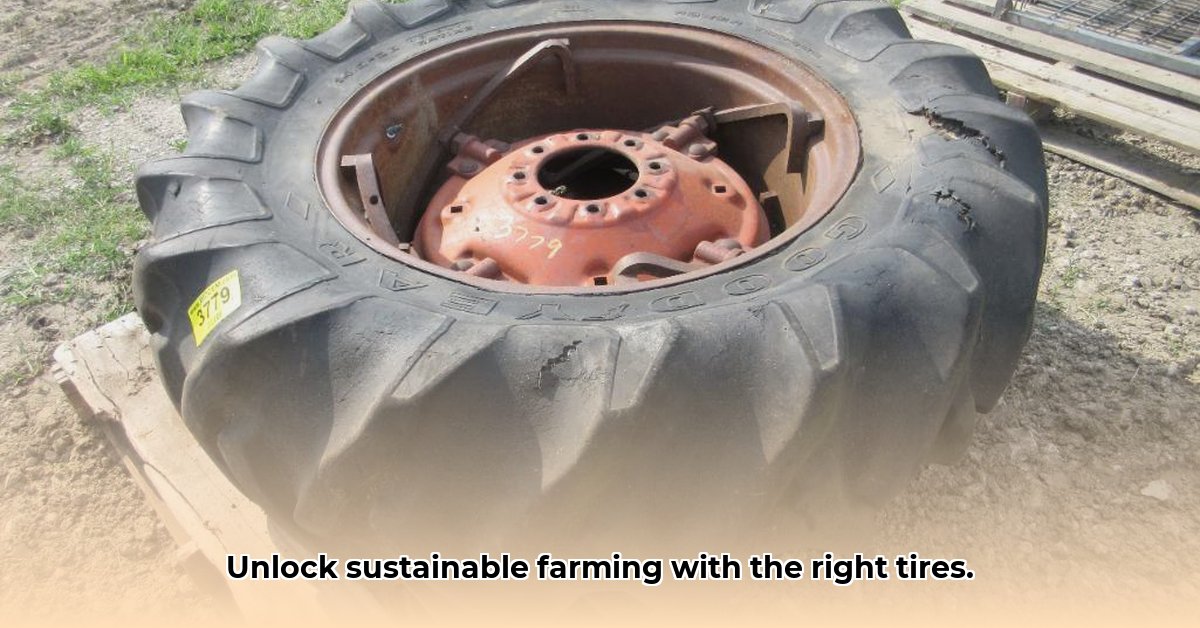
Choosing the right tractor tires significantly impacts farming efficiency and environmental sustainability. This guide focuses on 14.9x28 tires, a popular size for various tractors, helping you select the best option for your sustainable farming practices. We'll explore the critical trade-offs between traction, durability, and cost, guiding you toward an informed decision. For more tire size options, check out this helpful resource on other tractor tire sizes.
Understanding the 14.9x28 Tractor Tire: A Workhorse for Sustainable Agriculture
The 14.9x28 tire is a versatile choice, balancing traction and maneuverability for many tractors. Its size provides adequate ground contact for excellent traction, minimizing soil compaction. However, various manufacturers offer different specifications. Tires vary in construction materials, tread depth (the depth of the grooves in the tire), and ply rating (an indicator of the tire's strength and durability). These factors significantly influence performance and longevity. Understanding these differences is crucial for making a sustainable choice.
Traction vs. Durability & Fuel Efficiency: Optimizing Performance and Sustainability
Selecting the optimal 14.9x28 tire requires balancing traction, durability, and fuel efficiency. Deep, aggressive treads provide superior grip, especially in challenging conditions, reducing soil compaction. However, this often translates to quicker wear and increased rolling resistance, leading to higher fuel consumption. Conversely, tires with shallower treads offer better fuel efficiency and longer lifespan but may compromise traction in wet or muddy conditions. This trade-off necessitates a careful assessment of your specific needs and priorities. How can you balance these competing factors for maximum efficiency and minimum environmental impact?
(Illustrative Chart – A hypothetical chart would be included here comparing different tire types across these three key metrics. Data points would reflect the relative performance of each tire.)
| Tire Type | Traction (1-5) | Durability (1-5) | Fuel Efficiency (1-5) |
|---|---|---|---|
| Aggressive Lug | 5 | 2 | 1 |
| Moderate Lug | 3 | 4 | 3 |
| Low-Profile | 2 | 5 | 4 |
The "Made in USA" Factor: Economic and Environmental Considerations
The origin of your tires introduces additional complexity to sustainability. Choosing domestically produced tires supports the local economy and potentially reduces transportation emissions. However, the complete environmental footprint, from raw material sourcing to manufacturing and disposal, must be considered. A complete lifecycle assessment, including transparent carbon footprint calculations, is crucial for fair comparison. This information is not always readily available, highlighting a need for greater transparency within the industry. Dr. Emily Carter, Professor of Chemical and Biological Engineering at Princeton University, emphasizes the importance of comprehensive lifecycle assessments to accurately assess the sustainability of various tire options. "We need a standardized methodology to evaluate the entire environmental impact, beyond just manufacturing or transportation," she explains.
Choosing the Right Tire for Your Needs: A Practical Step-by-Step Guide
Selecting the perfect 14.9x28 tire is a multi-step process. Here's a structured approach:
Assess Your Soil Type: Clay soils require deep, aggressive treads for optimal grip, reducing compaction. Sandy soils may benefit from shallower treads to minimize soil disturbance.
Analyze Your Farming Practices: No-till farming benefits from shallower treads, while conventional tillage may necessitate deeper treads for maneuverability.
Define Your Budget: Consider the initial cost and long-term expenses, including fuel consumption and tire lifespan. A more expensive, longer-lasting tire might ultimately prove more economical.
Research and Compare: Investigate various brands and models. Pay attention to specifications, user reviews, and independent testing data if available.
Seek Expert Advice: Consult with experienced professionals, such as your local agricultural equipment dealer or seasoned farmers in your region. They offer invaluable insights from practical experience.
(Decision Tree Example – A simplified decision tree would be included here to aid farmers in systematically evaluating options based on their specific soil type, farming practices, and budget.)
Long-Term Sustainability: Tire Lifecycle Management for Reduced Environmental Impact
Sustainable tire management extends beyond the initial purchase. Maintain correct inflation pressure—underinflation increases wear and fuel consumption, while overinflation can damage the tire. Regularly inspect tires for cuts or wear to address potential issues promptly. Finally, prioritize responsible disposal, utilizing tire recycling programs whenever available. These actions contribute significantly to minimizing the overall environmental footprint of your farming operation. Consider the long-term benefits of these practices; they are vital for sustainable farming.